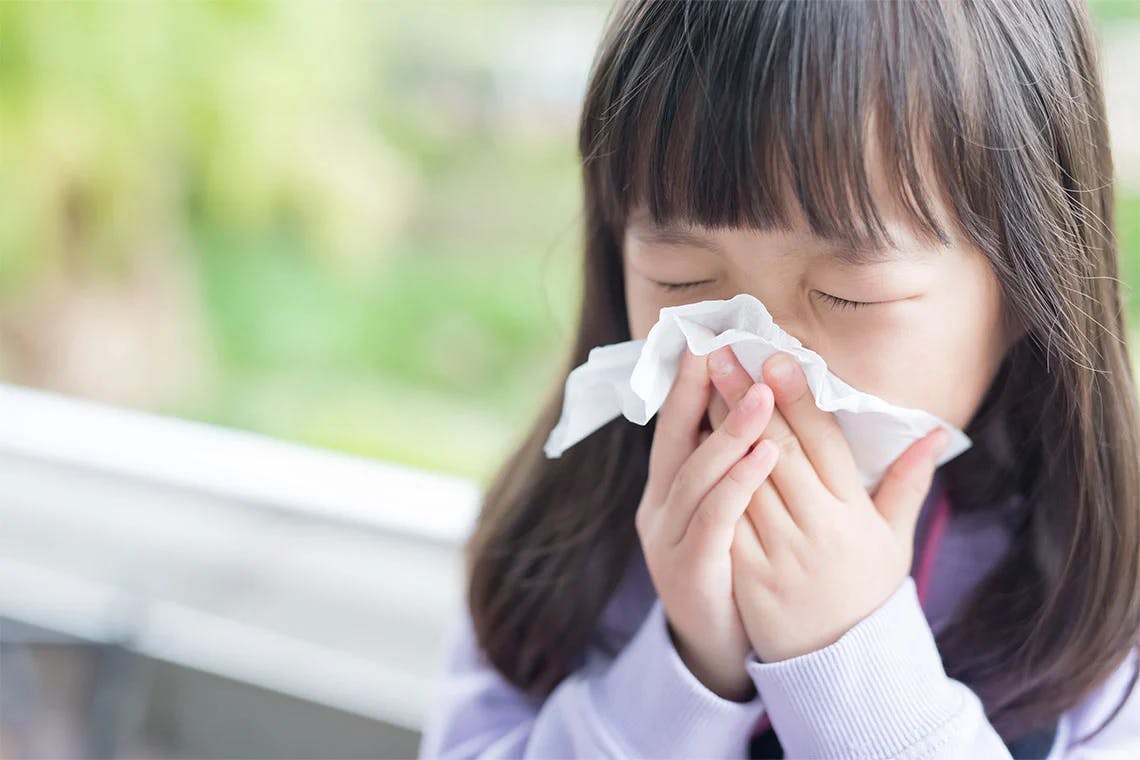
How to Tell If Your Kid Has Seasonal Allergies
Allergies can cause symptoms that are like a cold. Sneezing, coughing, runny and stuffy noses are all shared symptoms. When your kid is dealing with these symptoms, it might be difficult to tell whether or not they need allergy medications or cold remedies.1 Learn about the seasonal allergy symptoms in kids, how seasonal allergies are diagnosed and how your child can get some relief.
What Are Seasonal Allergy Symptoms with Kids?
Seasonal allergies, or allergic rhinitis, is caused by an allergic response to a substance that the body identifies as an allergen.2 Allergens can include the following:3
- Pollen: Pollen comes from weeds, flowers and trees. Pollen is released in the air to help fertilize plants, and the amount of pollen in the air can depend on the weather and season.
- Pet dander: Dead skin from dogs, cats, birds and other animals can be allergens. When they get in the air or on clothes, they can cause an allergic reaction for many kids. If you are seeking a new pet for your home, consider exploring hypo-allergenic companions to potentially help prevent triggering an allergic reaction in your children.
- Mold: Mold can live anywhere in your house, especially areas that are dark and moist. Make sure your living quarters are clean, and there is no water damage in your home, or else you may be providing an environment for mold to thrive in.
- Dust mites: Dust mites can live in furniture, bedding, carpets and other upholstery. You can’t see them, but they can be found in house dust all around your home.
When you breathe an allergen through your nose or mouth, your body releases a natural chemical called histamine.2 Histamine is released to help eject the allergen, causing mucous membranes to become inflamed and itchy.3 This reaction can cause cold-like symptoms in children and adults, which include the following:2
- Runny and stuffy nose (congestion)
- Sneezing
- Cough
- Itchy nose, roof of mouth or throat
- Postnasal drip or mucus that runs down the back of your throat
- Fatigue, due to poor sleep
- Swollen, bruised-appearing skin under the eyes
- Wheezing and trouble breathing
- Headaches, dark circles under eyes and pain coming from sinuses
- A general feeling of discomfort or malaise
If you are uncertain if your child has seasonal allergies, there are a few indicators. If your child is experiencing “colds” at certain times during the year, it is possible that they are allergies. Seasonal allergies are heightened during the spring, summer, and early fall when pollen counts are higher.2 Additionally, if your child has asthma or eczema, they also may have a higher change of developing seasonal allergies.2
How to Test Your Child for Seasonal Allergies?
If you suspect your child has seasonal allergies, talk to your healthcare provider. Detail your symptoms and if appropriate, they will evaluate them to pinpoint any allergies. Evaluation may include an immunoglobulin E (IgE) test.4 Your healthcare provider will take a blood sample from your child and measure their antibodies for different allergens. 4
In addition to the IgE test, they may also suggest a skin prick test. Your healthcare provider will place a small sample of allergens on your child’s skin and prick it with a needle to get underneath the skin.4 If your child is affected by the allergen, i.e., their skin becomes red and irritated, they likely have an allergy.4 This skin prick test is a safe and effective way to determine what allergens are causing an allergic reaction. 4
Testing for seasonal allergies is the first step to help your child get relief.4 If their symptoms are disrupting their daily life or making it hard to sleep, consider talking with your healthcare provider to help determine which allergens are causing a reaction.4
Treatments for Children with Seasonal Allergies
As a parent, one of the ways you can assist your child combat seasonal allergy symptoms is by helping them avoid allergens. Here are a few tips to keep pesky allergens at bay:3
- Make sure your child isn’t touching their face or rubbing their eyes or nose. They can pick up allergens on their hands in school, outside, etc. and transfer the allergen to their body.
- Keep their hands clean. Hands should be washed after playing outside or with pets.
- Change your children’s clothes after they play outside.
- When pollen counts are higher, make sure to close the windows in your home.
- Clean your home regularly to reduce the number of allergens in the air. Vacuum your home regularly and turn the air conditioner on to filter the air in your home.
- Put dust mite covers over your mattresses, box springs and pillows.
- Use a dehumidifier to keep the air dry indoors.
In addition to taking precautions to lower contact with allergens, your child can also try over-the-counter medications. Children’s Flonase can help relieve your child’s allergy symptoms including sneezing, runny rose, nasal congestion and itchy and watery eyes. You can also try other ways to treat allergies with over-the-counter medications like antihistamines and nasal decongestants.
Helping your child navigate seasonal allergies doesn’t have to be difficult. You can get them tested, determine how to help them avoid triggers and follow instructions from your medical practitioner for additional treatment. Learn more about allergy symptoms and tips with Flonase.
Source Citations:
- Cold or Allergy. Mayo Clinic. https://www.mayoclinic.org/diseases-conditions/common-cold/expert-answers/common-cold/faq-20057857 . Accessed 5/23/2023.
- Allergic Rhinitis Hay Fever. Cleveland Clinic.https://my.clevelandclinic.org/health/diseases/8622-allergic-rhinitis-hay-fever. Accessed 5/23/2023.
- Seasonal Allergies. Mayo Clinic. https://www.mayoclinic.org/diseases-conditions/hay-fever/in-depth/seasonal-allergies/art-20048343. Accessed 5/23/2023.
- Allergy Testing. Cleveland Clinic. https://my.clevelandclinic.org/health/diagnostics/21495-allergy-testing. Accessed 5/18/2023.